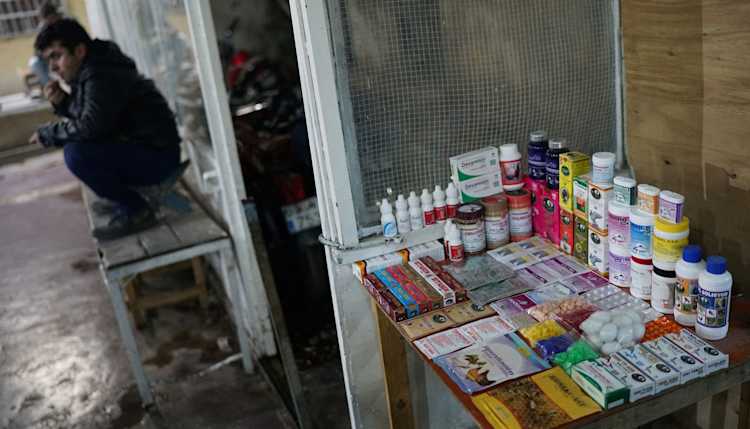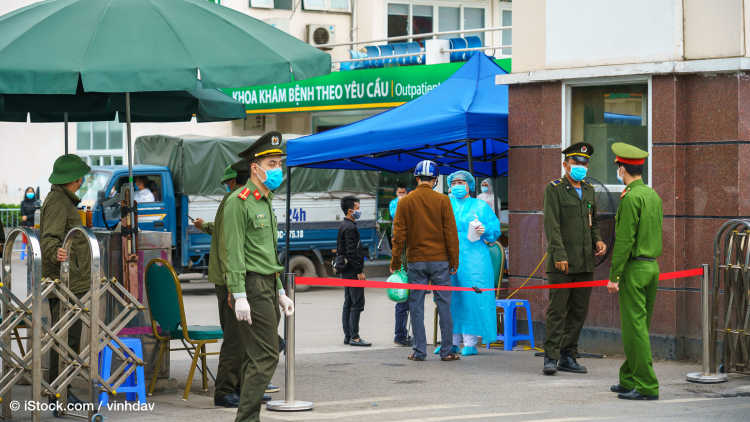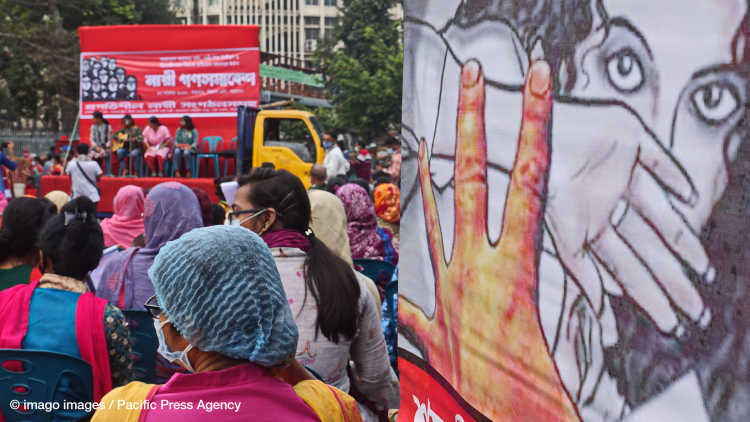- Startseite
- Publikationen
- GIGA Focus
- COVID-19 in the Middle East and North Africa: Reactions, Vulnerabilities, Prospects
GIGA Focus Nahost
COVID-19 im Nahen Osten und in Nordafrika: Reaktionen, Gefährdung, Perspektiven
Nummer 2 | 2020 | ISSN: 1862-3611

There have been three different kinds of reactions to the coronavirus crisis: those from early movers, with extensive measures taken (Israel, Jordan, Gulf countries, Morocco); those from states that initially struggled to acknowledge the magnitude of the crisis out of concern about its economic impact (Iran, Turkey, Egypt); and, those from countries whose ability to react to the crisis is in doubt because of civil war and internal disarray (Yemen, Libya, Syria).
The capacities of regional health systems are lagging in comparison to international peers. The median age of the population is relatively low. However the number of vulnerable elderly is still substantial, as the region has been undergoing a demographic transition for several decades now. Other at-risk groups are the poor, labour migrants, the prison population, refugees, and internally displaced persons.
The economic impact of COVID-19 will affect domestic spending and threatens to undermine the social contract and political stability. The pandemic also has the potential to shake up geopolitical dynamics, as it will reduce the ability of key actors to intervene regionally (e.g. Iran, Saudi Arabia, Russia).
The coronavirus crisis requires government intervention on a large scale. Such intervention will be used to further the political goals of authoritarian regimes, too. It will be integrated into their repression strategies – including cyber surveillance – and will likely outlast the health crisis itself. The pandemic is thus reinforcing trends towards populism and authoritarian restoration in the Middle East and North Africa.
Policy Implications
The European Union is currently preoccupied with its own coronavirus crisis, and struggling to find coordinated approaches to the tackling of it. Yet it should not overlook the unfolding socio-economic crisis in its southern neighbourhood. If Europe wants to be a serious geopolitical actor, it needs to find the wherewithal to provide assistance – and advertise that fact – to match similar efforts undertaken by China as part of its “mask diplomacy” in the region.
The Spread of COVID-19: Questionable Statistics
The Middle East and North Africa (MENA) region was catapulted into the spotlight regarding the coronavirus crisis when Iran registered its first case on 19 February, and developed into the second-gravest centre of the pandemic after China at that time. The magnitude of the problem was illustrated by the large number of high-ranking officials who contracted the disease: among them was deputy health minister Iraj Harirchi, who was in charge of Iran’s COVID-19 task force.
Most other MENA countries reported their first cases in the second half of February through 2 March. Relative latecomers were Turkey (11 March), Sudan (13 March), Syria (22 March), Libya (24 March), and Yemen (10 April). By that time Europe and then the United States had developed into the main hotspots of the pandemic; the MENA numbers of cases and deaths are high as well however, with them dramatically rising in some countries and likely underreported for lack of testing facilities.
As of 20 April, Turkey (86,306), Iran (82,211), and Israel (13,491) had registered the largest number of cases in the MENA region, accounting for the lion’s share of a total of 220,980 according to Johns Hopkins University. However, the accuracy of these statistics is a concern. Even highly developed countries have struggled to implement mass testing, and not all COVID-19 death cases might be accurately accounted for. A recent study by the University of Göttingen argues that the average COVID-19 case-detection rate might be as low as 6 per cent (Bommer and Vollmer 2020). In Europe, the COVID-19 death rate from officially recorded cases hovers between 3.2 per cent in Germany and 13.2 per cent in Italy. In the MENA death rates differ widely too, from below 1 per cent in the smaller Gulf countries to 14.3 per cent in Algeria, leading to a regional average of 3.8 per cent.
Turkey was one of the last countries to report its first case in the MENA, and has now one of the steepest growth trajectories in that regard globally. Egypt was an early reporter of the first case (14 February), but had only 3,144 as of 20 April. Despite relatively low official numbers, the German Robert Koch Institute classified it a high-risk area on 21 March amid doubts about those official statistics. Low numbers might reflect a lack of testing facilities, rather than reality. Some governments such as those of Turkey, Egypt, and Algeria have also shown the political will to suppress bad news and censor whistle-blowers. It is striking that the MENA countries with the lowest numbers of cases are the ones poorest and with the least resilient health systems, often ravished by civil war. As of 20 April, Sudan had reported 92 cases, Libya 51, Syria 19, and Yemen only 1 – hardly credible, as the World Health Organization warned of a pending “explosion” of cases in the latter country.
Most MENA countries had started to implement travel restrictions from China by the end of January, which were extended to other world regions over the following month up until mid- March – when air travel completely ground to a halt. Syria and Lebanon had maintained air travel to and from Iran longer than others out of political expediency, which gave rise to claims of negligence. By the second half of March, most countries had closed schools, mosques, churches, and synagogues and implemented some sort of lockdown regime with different degrees of scope and enforcement. Israel, Jordan, Gulf countries, and Morocco were early movers, with relatively extensive measures taken; Iran, Turkey, and Egypt initially failed to acknowledge the magnitude of the crisis, and cracked down on whistle-blowers given concerns about the outbreak’s economic impact. In Libya, Yemen, and Syria meanwhile the ability to react to the crisis is in doubt because of civil war and internal disarray, while anecdotal evidence suggests that curfews are only partially observed.
State Capacity, the Health System, and Vulnerabilities
State capacity to implement COVID-19 countermeasures in the MENA has its limitations. This is particularly true for the healthcare sector. It limits the possibilities of the region to cope with the peculiar vulnerabilities of its population, with considerable variations between poor, rich, and war-torn countries. Heavy reliance on oil rents by some states alongside the limited reliance of others on the regional recycling of such rents via strategic transfer payments and investments imply a reduced dependence on tax collection. As a result, administrative capacities to rule deep into society are underdeveloped. Administrations are top-heavy, there is no tradition of municipal autonomy, and discretionary power to make decisions on the lower rungs of administrative hierarchies is limited. MENA states are centralised but weak. They have limited social control and ability to penetrate and regulate society, or to extract resources from it for later appropriation. As “infrastructural power” is low, the focus of regime survival shifts to the “despotic power” of repression instead (Springborg 2020).
Capacities of MENA health systems are lagging in comparison to international peers. Together with African countries, they are at the lower end of the Global Health Security Index 2019 that measures the robustness of a health system in terms of clinical capacity, protection of health personnel, crisis communication, and availability of medical supplies (Stöhr and Stotz 2020). Only Israel, Saudi Arabia, and Turkey manage to score mid-level positions in the 40s (out of 100); Iran, Qatar, Kuwait, and Morocco follow with numbers in the 30s, or close to it. The United Arab Emirates ranks relatively low for a rich country, with a score of only 22.9. Algeria, Sudan, and Egypt score well below 20, while Libya and Yemen mark rock bottom with values below 10. This does not compare favourably with the global average of 40.2, and an average score of 51.9 among the 60 highest-income countries in the world.
The limited capacities of the MENA health systems are up against a number of vulnerabilities and peculiarities when facing the COVID-19 pandemic. Compared to Organisation for Economic Co-operation and Development (OECD) countries, the population in the region is relatively young. The median age of the population is 27, as opposed to 42.5 in Europe. There are fewer older people above 65, being those particularly vulnerable to succumbing to COVID-19. However the MENA’s median age is well above that of the least-developed countries, where it is 20. MENA societies are not as young as is sometimes assumed. Many of them are well ahead in a long-term demographic transition, with birth rates around the replacement ratio of 2.1 children per woman (e.g. Lebanon, Iran, Turkey, Tunisia). Youth bulges already peaked in the 1970s in North Africa and in the 1990s in the Middle East. There are 30 million elderly over 65 among a total population of about 500 million people.
COVID-19 affects the poor more than the affluent. The former can ill afford to shelter in place, blue-collar occupations cannot be conducted from the safety of one’s own home, and cramped living quarters can increase the risk of contagion. Once the poor have contracted the disease they face further disadvantages, as they have less access to healthcare. COVID-19 will likely affect poorer MENA countries with high shares of informal housing and employment more than the affluent ones of the region. But even the oil-rich Gulf countries have population pockets that are more vulnerable than others, namely labour migrants and people with unclear residency status. Qatar has implemented a rigorous quarantine programme in its labour camps, while anecdotal evidence suggests that the UAE has started to repatriate some of its foreign labour by loosening the flight ban and allowing these people out of the country. Mecca, Medina, and Jeddah have large shantytowns that are home to descendants of migrants from Africa and Southeast Asia who came to Saudi Arabia decades ago and overstayed their visas. They form a permanent underclass with limited legal rights. The recent decision of the Saudi government to open the healthcare system to everybody for COVID-19 treatment regardless of their legal residency status is an implicit acknowledgement of this public health risk. A similar concern pertains to the highly vulnerable refugees and internally displaced persons in Turkey, Lebanon, Jordan, Iraq, Libya, and Syria.
The Gulf countries and Egypt have among the largest per capita shares worldwide of people suffering from diabetes and obesity, two groups particularly at risk of succumbing to COVID-19. The Gulf countries also have a skewed gender balance because of predominantly male labour migration. Women make up only one-quarter of the population in Qatar, 30 per cent thereof in the UAE, and 42 per cent of it in Saudi Arabia. As COVID-19 apparently affects men more than women, this could make these countries more susceptible to the pandemic. Contagion in cramped prisons is another risk factor, particularly in those countries that have seen a steep rise in the number of political prisoners interned such as Egypt, Turkey, Syria, and Iran. The Iranian government admitted as much when it ordered the temporary release of 85,000 prisoners in mid-March in order to curb the spread of the virus. The Assad regime in Syria also announced a partial amnesty on 22 March to reduce pressure on overcrowded prisons. In both cases political prisoners were largely excluded from the amnesty, which focused rather on ordinary criminals.
In Syria, the selective allocation of public goods such as electricity to population segments that are supportive of the regime has been observed. Similar spatial selectivity of coronavirus-related healthcare and relief efforts might occur elsewhere in the region too, not only in Syria. The insurgent pocket of Idlib, Syria, Kurdish areas of Turkey, Arabic-speaking Khuzestan in Iran, Israeli-occupied Palestinian territories, or Saudi Arabia’s Eastern Province that has a large Shi’a population might rank lower on the priority scales of the respective governments. On the other hand, there is reason for cautious optimism. Cooperation between the Israeli and Palestinian administrations has occurred, while there have been relief efforts and solidarity campaigns for the particularly hard-hit Eastern Province of Saudi Arabia – where returning pilgrims from the Shi‘i shrines in the Iranian city of Qom represented the first cases of COVID-19 in the country.
Finally, war has debilitated health systems in Libya, Syria, and Yemen. The need to cater to the wounded also constitutes an additional burden on already overwhelmed health systems and further reduces their capacity to react to the pandemic per se. Yemenis are already suffering from severe malnutrition and a cholera epidemic, which make them particularly vulnerable in case of COVID-19 infection. Sanctions can have an adverse effect, too. Food and medicine are typically excluded from sanctions for humanitarian reasons, but financial sanctions can curtail their import as access to trade finance is impossible and foreign assets are frozen. Currently the US is opposing an Iranian request for a USD 5 billion credit line from the International Monetary Fund to facilitate COVID-19-related relief, which prompted Iranian president Rouhani to accuse the US of “medical terrorism.”
Economic Impact: Oil, Tourism, Food Imports, and Finance
COVID-19 will affect domestic spending, and threatens to undermine the social contract and political stability. The pandemic also has the potential to shake up geopolitical dynamics, as it will reduce the ability of key actors to intervene regionally. The importance of oil for the MENA’s economies can hardly be overstated. It forms a large share of gross domestic product and an overwhelming majority of exports as well as of government revenues in many countries of the region. It underpins the social contract of rentier states. They redistribute oil rents via public services and transfer payments, and expect political acquiescence to their authoritarian ways of governing in return. Oil is crucial for the extreme rentiers with very high rents per capita (Kuwait, Qatar, UAE), but also for middling rentiers (Bahrain, Libya, Oman, Saudi Arabia) and for poor rentiers – whose high rent share results only from their economies not producing much else (Algeria, Iran, Iraq, Yemen). In semi-rentier states like Egypt, Jordan, and Syria the rent endowment per capita is too small to enjoy the same distributional discretion as the full rentier states. They only have some domestic rents from oil, gas, and potash, but they have been integrated into the regional recycling of oil rents via strategic transfer payments from Gulf countries; they have benefitted from migrant remittances too.
Oil prices were below the budget break-even prices of most rentier states even before COVID-19’s outbreak. Only Kuwait and Qatar were able to (barely) make ends meet. The supply shock of the unconventional oil revolution in the US, demand destruction in the wake of the Great Recession, and concerns about growing e-mobility have weighed on the sector (Woertz 2019b). Price declines and the initially failed renewal of the OPEC+ agreement ignited an oil price war between Saudi Arabia and Russia over market share on 8 March, right at the onset of the coronavirus crisis, which can bring demand destruction of up to 20 million barrels per day (mbpd) according to the International Energy Agency – unprecedented in scale. Faced with events of this magnitude both countries rowed back only a month later and reached a truce, agreeing on production cuts of 10 mbpd in May and June of 2020, to be followed by lower cuts of 8 mbpd for the rest of the year and sustained cuts of 6 mbpd from January 2021 to April 2022.
The oil-market rout has far-reaching geopolitical implications. Rentier states will struggle to fulfil their social contract and maintain domestic spending. They will repatriate foreign assets and need to access international capital markets for debt issuance, which will become more difficult and costly to obtain. Iran enjoys no such access at all as a result of sanctions. One poorer rentier, Oman, has already been downgraded by credit-rating agencies. Ambitious projects of economic diversification in Saudi Arabia and elsewhere are in question (Woertz 2019a).
The ability to import arms and project force abroad will decline. The relative costs of regional intervention will rise for Russia, Iran, and Saudi Arabia. The temporary ceasefire that the Saudi led-coalition announced in Yemen at the end of March 2020, undertaken with the face-saving argument that it would help to prevent a coronavirus outbreak in the country, is a sign that Saudi Arabia is seeking a way to extricate itself from this costly foreign policy adventure. The Kingdom was also the world’s largest arms importer between 2015 and 2019; it might be forced to reduce such purchases, which until now have been an essential aspect of its relationship with a transactional White House. Egypt and others will not be able to count as easily on strategic transfer payments from Gulf countries to cover their budget deficits. Iran on the other hand will likely bear the higher costs and maintain its proxy strategy in countries like Iraq, Syria, and Lebanon to safeguard the extensive strategic investments it has made in them. However, its ability to provide economic aid and create goodwill was never great by any standard and will suffer further, possibly creating popular resentment – as already evidenced in the pre-pandemic protests witnessed in Lebanon and Iraq.
Lower oil prices will provide some relief to oil importers of the region such as Turkey and Lebanon, but this is overshadowed by the financial havoc that the coronavirus crisis is wreaking. Both countries have covered their substantial current account deficits with capital imports for decades. Now they face additional problems in continuing this practice, especially Lebanon – which defaulted on its debt for the first time on 9 March.
Other sectors will suffer, too. Value chains of North African industries for textiles and car supply parts are disrupted. Tourism is a major factor in the economies of Morocco, Tunisia, Egypt, Turkey, and Jordan but also of Saudi Arabia, which receives each year millions of pilgrims – not to mention of the UAE and its logistical hub Dubai. Emirates airlines stopped all passenger flights on 25 March, and Saudi Arabia will likely cancel this year’s pilgrimage season. The super-carrier and transit-hub business model that Gulf airlines have pursued successfully for many years is in question. Tourism has all but collapsed as a result of the coronavirus crisis, and is unlikely to recover swiftly. Any exit scenario from current lockdown measures will be gradual, and attitudes towards international travel will be more conservative in the pandemic’s aftermath.
The MENA is the world’s largest importer of cereals, while also importing copious amounts of meat and dairy products from far away. Affordable food and subsidies of food staples are a key aspect of the social contract in many countries of the region. Temporary supply disruptions in the wake of the global food crisis of 2007/2008 spooked MENA countries. They reacted with increased storage at home, and a scramble for privileged bilateral access to food production via investments in farmland and – more importantly – companies involved in food trade, processing, and distribution (Woertz 2013). The coronavirus crisis has reignited similar fears in the relatively urbanised MENA region, where most people rely on markets for daily supplies. Globally, food value chains will suffer more than the farming sector, which might only face temporary labour shortages. The more modern and capital-intensive value chains that dominate in developed countries and emerging markets will be less affected than the traditional and transitional food value chains that still play a major role in most MENA countries (outside the Gulf region, Turkey, and Israel).
Some MENA governments are able to cushion the pandemic’s economic impact with relief aid. Saudi Arabia has decided to pay 60 per cent of the salaries of Saudi employees in the private sector for three months. Even a less affluent country like Morocco was able to create a solidarity fund of EUR 3 billion, to which the European Union has contributed EUR 150 million (Baade et al. 2020). In the medium term, this might not be enough and could have political consequences.
Will COVID-19 Empower or Unmask Authoritarianism?
The outlined massive economic impact will reduce the fiscal space of MENA regimes and their ability to fulfil their bargain within the social contract. Long-standing socio-economic grievances will be aggravated. Once the dust settles, recent dynamics of protest movements and regime-survival strategies will likely be accentuated – including increased recourse to repression. The MENA largely escaped the third wave of global democratisation that lasted from the 1970s to the 1990s. With the exception of Tunisia, the Arab Spring did not break this trend. Spring has turned into winter, and authoritarian backlash has reared its ugly head once more. Strategies of repression have become more sophisticated, and expanded into cyberspace (Josua 2019). Even countries that can be classified as flawed democracies or hybrid regimes according to the Democracy Index of The Economist Intelligence Unit, such as Israel and Turkey respectively, have shown increased populist – if not authoritarian – tendencies. On the other hand, new waves of protest have occurred in Algeria, Sudan, Lebanon, and Iraq, countries that had remained on the sidelines during the initial Arab Spring. They are a reminder of the festering grievances in the region that can turn social protest into destabilisation of the currently prevalent political orders.
One immediate effect of the coronavirus crisis is that it has accomplished what authoritarian repression was often unable to: preventing public manifestations of discontent. In Algeria, protesters called off their marches for the first time in over a year. Another effect is the opportunities for increased cyber surveillance, which has been tightened since the Arab Spring. Even non-authoritarian governments in the region show worrying trends in that regard. Israel has expanded cyber surveillance without parliamentary approval, invoking emergency orders (Landau, Kubovich, and Breiner 2020). The coronavirus crisis has provided Netanyahu with a welcome opportunity to bypass parliament after three inconclusive elections and rule by decree, while also shutting down the courts that were about to begin legal proceedings against him on corruption charges. This prompted best-selling author Yuval Noah Harari to speak of a “coronavirus dictatorship.” Tunisia has also allowed government by decree according to Article 70 of its constitution.
If a crisis is the hour of the executive, populist and authoritarian leaders did not, initially at least, step up to the plate. Rather they sought to belittle the coronavirus’s impact, promised magic cures, or blamed the situation on malign foreign influence. The MENA region has seen its own acts of denial, similar to the initial cover-up in China and the more recent doubts about the accuracy of its COVID-19 statistics, or the waxing and waning of populists like Trump in the US, Bolsonaro in Brazil, and López Obrador in Mexico that led to lagging reactions in their respective countries (Blofield, Hoffmann, and Llanos 2020).
The Iranian regime initially covered up the outbreak, too. It was anxious to guarantee voter turnout for the parliamentary elections on 21 February, and feared the economic impact of a health crisis on a country that already suffers from extensive US sanctions. Later, at the end of March, Iranian supreme leader Khamenei rejected an US offer for coronavirus-related aid, insinuating that the virus could have been developed by the US government and went as far as alleging that it “is specifically built for Iran using the genetic data of Iranians, which they have obtained through different means” (Al Jazeera 2020). On 20 April, the country embarked on a gradual relaxation of its lockdown, what prompted experts to warn that it came too early and could lead to a renewed acceleration of the outbreak. In Algeria, the government summoned the French ambassador to protest a critical report on France24 that questioned the effectiveness of Chinese aid – as it primarily benefitted a hospital reserved for the military elite (Asharq al Awsat 2020).
As late as the end of March, President Erdogan still insisted that “Turkey is a country where production must continue and the cogs must keep turning under every circumstance and every condition.” Further, he only recommended a lukewarm “voluntary quarantine,” prompting experts to speculate about a “hidden herd-immunity agenda” (Chotiner 2020). Official COVID-19 numbers are in doubt. Whistle-blowers and doctors who have been forthcoming about the magnitude of the problem have been intimidated, while pundits on state-controlled television were free to speculate that the superior quality of their genes made Turks more resistant to COVID-19.
Similar tactics could be observed in Egypt as well. When disease specialists from the University of Toronto doubted the official Egyptian statistics on COVID-19 cases, the Ministry of Health dismissed their higher estimates as “completely false” and claimed that it reported cases with “full transparency.” At the same time, however, Egypt would expel a Guardian journalist who had reported on the issue, not unlike China – which revoked the press credentials of Wall Street Journal reporters on 19 February over a controversial op-ed. As in Turkey misinformation on state-controlled media occurred, with pundits on television praising the health benefits of Egyptian ful (a national dish made from fava beans) as a countermeasure to the disease.
Another source of disinformation can be religious circles, who have argued against curtailments of public religious services. Iranian ultra-conservatives have protested against the closure of the holy Shi‘i shrines in Qom, while the Moroccan government arrested the Salafist Abou Naim after he argued that the coronavirus-induced closure of mosques was a pretext for a government strategy of fighting religion. Similar rumblings can be observed in Egyptian debates. In the ensuing Ramadan season – set to start in late April, with its iftar (breaking of the fast) gatherings an important source of food for the poor – such debates will likely gain in intensity. At the same time pressure will mount on regimes to lift lockdowns for economic reasons, or as a Tunisian construction worker put it: “We need food and solutions, we will die if this continues, at least the virus is curable but what can we do for the hunger?” (Barbarani 2020).
Whither MENA–EU Relations
The combination of reduced fiscal space, increased socio-economic grievances, and the poor handling of the coronavirus crisis will further undermine the already-damaged legitimacy of MENA regimes – to which they will likely react with greater repression. Beside this domestic dimension there is an international one too, whose impact is yet harder to evaluate. The coronavirus crisis will certainly affect the international system. It could result in national withdrawal, further weaken multilateralism, or it could strengthen the international order if states rally together out of a necessity to cooperate. In the worst-case scenario it could coalesce into a new Cold War scenario, albeit with the US and China now constituting the bipolar powers. Like in Italy and Serbia, China is using coronavirus-related assistance to enhance its standing and soft-power appeal in the MENA too (Haddad-Fonda 2020). As part of this “mask diplomacy,” Chinese emergency deliveries have arrived to much public fanfare in Egypt, Algeria, Iraq, Sudan, and Iran.
In contrast the EU has given the impression that it is either not willing or not able to help its own member states such as Italy and Spain, let alone the countries situated in its southern neighbourhood. Individual member states implemented export bans on medical equipment and kept purse strings tight when asked to decide on emergency measures. As part of its stated intention to become a more geopolitical union, the EU should advertise its existing assistance to close collaboration partners such as Morocco, Tunisia, Jordan, and Lebanon more prominently and should consider expanding it throughout its strategically important southern neighbourhood. This could include a post-pandemic vision of increased economic collaboration, as once the dust settles industrial value chains will likely become less globalised and more regional – not only for medical supplies.
Fußnoten
Literatur
AlJazeera (2020), Iran Leader Refuses US Help; Cites Coronavirus Conspiracy Theory, www.aljazeera.com/news/2020/03/iran-leader-refuses-cites-coronavirus-conspiracy-theory-200322145122752.html (15 April 2020).
Asharq al Awsat (2020), Algeria to Sue ‘France 24’ over Hate Speech Against Its Army, in: Asharq al Awsat, 2 April, https://aawsat.com/english/home/article/2212701/algeria-sue-france-24-over-hate-speech-against-its-army (15 April 2020).
Baade, Christina, Michael Bauer, Simon Engelkes and Edmund Ratka (2020), Covid-19 in Nahost und Nordafrika: Belastungsprobe für eine instabile Region, 9 April, Berlin: Konrad Adenauer Stiftung, www.kas.de/en/single-title/-/content/covid-19-in-nahost-und-nordafrika (15 April 2020).
Barbarani, Sofia (2020), ‘We need food’: Tunisians Struggle under Coronavirus Lockdown, in: Al Jazeera, 12 April, www.aljazeera.com/news/2020/04/food-tunisians-struggle-coronavirus-lockdown-200411142312791.html (15 April 2020).
Bommer, Christian, and Sebastian Vollmer (2020), Average Detection Rate of SARS-CoV-2 Infections is Estimated around Six Percent, University of Göttingen, www.uni-goettingen.de/en/606540.html (14 April 2020).
Chotiner, Isaac (2020), The Coronavirus Meets Authoritarianism in Turkey, in: The New Yorker, 3 April, www.newyorker.com/news/q-and-a/the-coronavirus-meets-authoritarianism-in-turkey (15 April 2020).
Haddad-Fonda, Kyle (2020), Can Beijing's Mask Diplomacy Win Hearts and Minds in the Arab world?, in: The New Arab, 1 April, https://english.alaraby.co.uk/english/comment/2020/3/31/can-beijings-mask-diplomacy-win-arab-hearts-and-minds (15 April 2020).
Landau, Noa, Yaniv Kubovich and Josh Breiner (2020), Israeli Coronavirus Surveillance Explained: Who's Tracking You and What Happens With the Data, in: Haaretz, 18 March, www.haaretz.com/israel-news/.premium-israeli-coronavirus-surveillance-who-s-tracking-you-and-what-happens-with-the-data-1.8685383 (15 April 2020).
Springborg, Robert (2020), Political Economies of the Middle East & North Africa. Cambridge, UK, Medford, MA: Polity Press.
Stöhr, Maria, and Patrick Stotz (2020), Welche Länder am besten auf die Coronakrise vorbereitet waren, in: Der Spiegel, 4 April, www.spiegel.de/politik/ausland/corona-krise-in-grafiken-so-sind-gesundheitssysteme-weltweit-auf-pandemien-vorbereitet-a-906a0530-3f59-4bef-bbfc-d863d0a7efb1?sara_ecid=soci_upd_KsBF0AFjflf0DZCxpPYDCQgO1dEMph (15 April 2020).
Woertz, Eckart (2013), Oil for Food. The Global Food Crisis and the Middle East. Oxford, New York: Oxford University Press.
Woertz, Eckart (2019b), The Energy Politics of the Middle East and North Africa (MENA), in: Kathleen Hancock and Juliann Allison (2019), The Oxford Handbook of Energy Politics, Oxford, New York: Oxford University Press.
Gesamtredaktion GIGA Focus
Redaktion GIGA Focus Nahost
Lektorat GIGA Focus Nahost
Regionalinstitute
Forschungsschwerpunkte
Wie man diesen Artikel zitiert
Woertz, Eckart (2020), COVID-19 im Nahen Osten und in Nordafrika: Reaktionen, Gefährdung, Perspektiven, GIGA Focus Nahost, 2, Hamburg: German Institute for Global and Area Studies (GIGA), https://nbn-resolving.org/urn:nbn:de:0168-ssoar-67334-7
Impressum
Der GIGA Focus ist eine Open-Access-Publikation. Sie kann kostenfrei im Internet gelesen und heruntergeladen werden unter www.giga-hamburg.de/de/publikationen/giga-focus und darf gemäß den Bedingungen der Creative-Commons-Lizenz Attribution-No Derivative Works 3.0 frei vervielfältigt, verbreitet und öffentlich zugänglich gemacht werden. Dies umfasst insbesondere: korrekte Angabe der Erstveröffentlichung als GIGA Focus, keine Bearbeitung oder Kürzung.
Das German Institute for Global and Area Studies (GIGA) – Leibniz-Institut für Globale und Regionale Studien in Hamburg gibt Focus-Reihen zu Afrika, Asien, Lateinamerika, Nahost und zu globalen Fragen heraus. Der GIGA Focus wird vom GIGA redaktionell gestaltet. Die vertretenen Auffassungen stellen die der Autorinnen und Autoren und nicht unbedingt die des Instituts dar. Die Verfassenden sind für den Inhalt ihrer Beiträge verantwortlich. Irrtümer und Auslassungen bleiben vorbehalten. Das GIGA und die Autorinnen und Autoren haften nicht für Richtigkeit und Vollständigkeit oder für Konsequenzen, die sich aus der Nutzung der bereitgestellten Informationen ergeben.

































